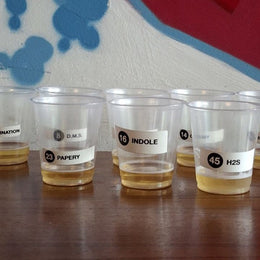
FIRST, WHAT IS MEZCAL?
Before we can dive into the differences, let’s first preface that any spirit distilled from the agave plant is considered a mezcal. Much like how scotch and bourbon are types of whiskey, mezcal is an umbrella term under which other distilled agave spirits like tequila, sotol, bacanora, and raicilla reside.
Mezcal didn’t start as the partier’s shot of choice, nor did it start as the drink that we know today. What was a fermented drink drank by the Aztecs and the Olmecs transformed when the Spanish arrived, bringing with them the art of distillation. They improvised with local products, the agave plant being one of them, essentially creating what we know today as mezcal.
THE DIFFERENCE BETWEEN MEZCAL AND TEQUILA
THE PRODUCTION METHOD IS DIFFERENT
Whilst it’s true that both are made from the agave plant, mezcals and tequilas are made from different kinds of agave plants. Unlike the tequila that can only be made from the Blue Weber agave plant found to the States of Jalisco. On the other hand, mezcal can be made from more than 30 varieties of agave, offering a wider range of flavours and aromas. Approximately 85% of all mezcals come from the State of Oaxaca, with the agave Espadin plant being the most in demand.
As for the distillation process, both mezcal and tequila are derived from the harvested core of the agave plant, the piña, but there’s where their similarities in production end. Tequila is typically produced by steaming the agave inside industrial ovens before it’s distilled two or three times in copper pots. Mezcal, on the other hand, is cooked inside earthen pits that are lined with lava rocks and filled with wood and charcoal. It has to undergo another round of distillation before it’s ready to be bottled. Mezcal doesn’t require any ageing in their production, unlike that of tequila’s where the ageing process holds great significance in the final product.

THEY ARE LABELLED DIFFERENTLY
Once they’ve passed the distillation process, both tequila and mezcal are placed inside oak barrels to kickstart the ageing process. However, the different ageing categories of the two spirits are defined slightly differently. For one, tequila comes in three different varieties: blanco/silver/plata (0-2 months), reposado (2-12 months), and añejo (1-3 years). Mezcal is also grouped into three categories by age: joven/blanco/plata (0-2 months), reposado (2-12 months), and añejo (at least 12 months).
THEY HAVE DIFFERENT FLAVOUR PROFILES
Mezcal is renowned for its smokiness, a flavour attribute that is derived from the more traditional method of cooking the piña in earthen pits. Depending on the agave plant and distillation process, you may also get a hint of other flavours, such as roasted bell pepper and chipotle. In addition, mezcals can also carry lingering floral, spicy, and fruity notes, adding to your overall mezcal experience.
Unlike mezcal, tequila doesn’t have a specific flavour profile. Instead, it carries a diverse range of flavours, partly due to the different terroirs: fruity and sweet highlands, and earthy and herbaceous lowlands, with both production areas being in Jalisco, Mexico. Its flavours are also dependent on the barrels they are kept in and the duration of their ageing process.
This feature is brought to you by Tequila Stop and the International Tequila Academy.
Tequila Stop aims to share is love for Mexico and its beloved Spirit with fans in Asia Pacific, bringing fans the best that Tequila has to offer, through an extensive catalogue of premium Tequilas and Mezcals straight from the source. Tequila Stop works closely with Mezcaleros across Mexico, and is also partners with the International Tequila Academy.








